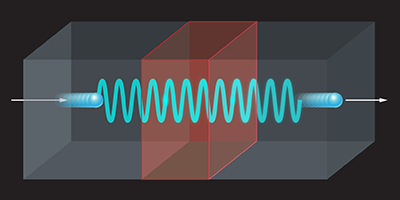December 4, 2013 report
Mathematical scientist suggests possible test for existence of axions

(Phys.org) —A mathematical scientist with the Isaac Newton Institute for Mathematical Sciences at the University of Cambridge, has proposed a possible way to test for the existence of axions—theoretical particles that might be possible components of dark matter. In his paper published in Physical Review Letters, Christian Beck suggests it might be possible to detect the existence of axions by using a Josephson junction.
The existence of dark matter is still just theory, as no one has yet been able to detect its actual physical presence—all such evidence thus far has been circumstantial. Key to proving that dark matter exists is finding a particle that might form its basis. To that end, researchers have been trying for years to detect weakly interacting massive particles (WIMPs), or the much lighter axion. Thus far, hints of success have been found with WIMPs but no one has yet come close to seeing any evidence of the existence of an axion. In his paper, Beck suggests there might be a way to do so, and, it should be a relatively easy process, because it might have actually been done before without those responsible realizing it.
Theory suggests, Beck notes, that an axion should be able to decay to a photon under certain circumstances and then revert back to its initial form. That suggests the opposite should be true as well. And if it did, it should be measurable via a release of an energy signal. He suggests that a Josephson junction (a junction made of regular metal sandwiched between two slices of superconducting material) might be a way to get the job done. The thinking is, if axions exist, they should be pouring down on us all the time, and if that is the case then they should in some cases decay to photons and revert back to form. If one happened to land on a Josephson junction, it might decay to a photon, pass through the sandwich and slip out the other side and then revert back to its natural axion state. And if that happened, it would have to leave behind a very small signal. And that is what's got Beck so excited. Back in 2004 a team working with a Josephson junction recorded a slight signal that they could not explain—one that Beck says fits the properties of an axion.
All that needs to happen now, he adds, is for someone to conduct experiments with Josephson junctions to see if they can reproduce the signal, and if so, prove that axions really do exist, and by extension, dark matter.
More information: Possible Resonance Effect of Axionic Dark Matter in Josephson Junctions, Phys. Rev. Lett. 111, 231801 (2013) prl.aps.org/abstract/PRL/v111/i23/e231801
Abstract
We provide theoretical arguments that dark-matter axions from the galactic halo that pass through Earth may generate a small observable signal in resonant S/N/S Josephson junctions. The corresponding interaction process is based on the uniqueness of the gauge-invariant axion Josephson phase angle modulo 2π and is predicted to produce a small Shapiro steplike feature without externally applied microwave radiation when the Josephson frequency resonates with the axion mass. A resonance signal of so far unknown origin observed by C. Hoffmann et al. [ Phys. Rev. B 70 180503(R) (2004)] is consistent with our theory and can be interpreted in terms of an axion mass mac2=0.11 meV and a local galactic axionic dark-matter density of 0.05 GeV/cm3. We discuss future experimental checks to confirm the dark-matter nature of the observed signal.
Journal information: Physical Review Letters
© 2013 Phys.org



















